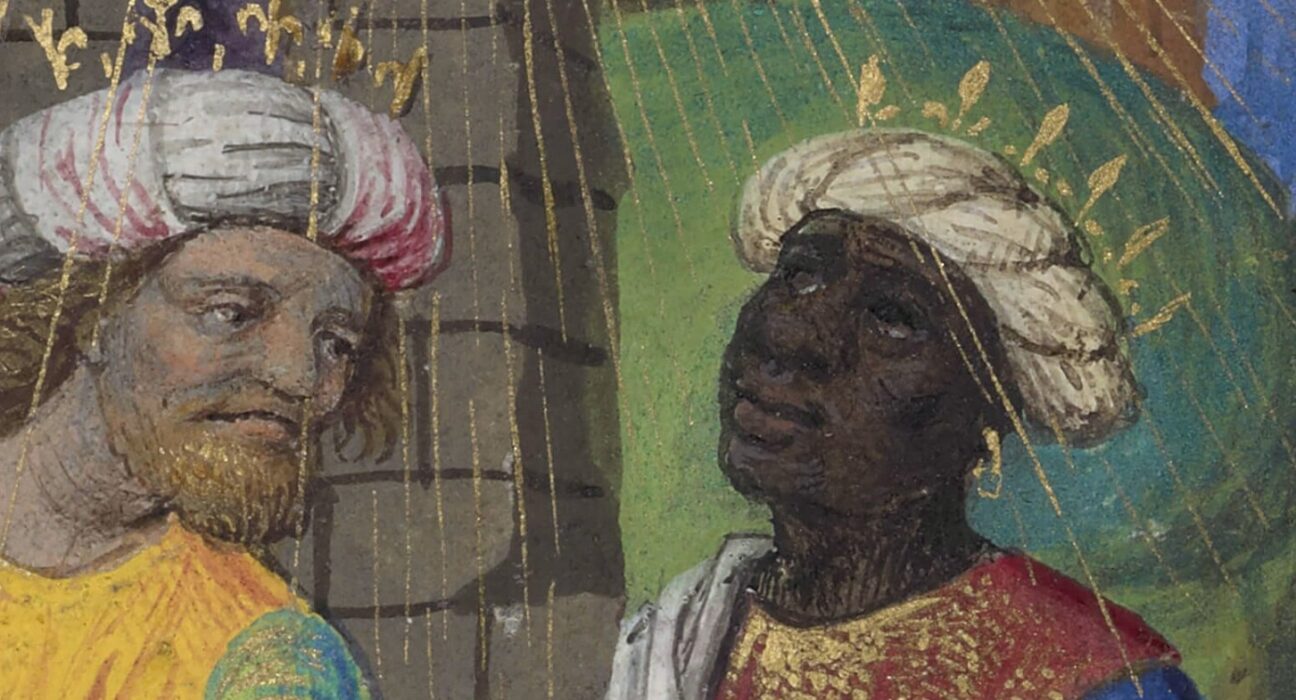Early medieval written legends report that one of the three kings who paid homage to the Christ Child in Bethlehem was from Africa.
But it would take nearly 1,000 years for European artists to begin representing Balthazar, the youngest of the three kings, as a black man. Why? The explanation can be found through a closer look at the history of this period—specifically, in the rise of the African slave trade in the mid-1400s.
The exhibition Balthazar: A Black African King in Medieval and Renaissance Art (November 19, 2019–February 17, 2020) examines how Balthazar’s depiction coincided with and was furthered by the rise of the slave trade.
To give context for the exhibition, we introduce the story of the Magi below, and give an example of how Balthazar’s depiction intersects with the history of Western colonialism.
Who Were the Magi?
The Adoration of the Magi was a common subject in European art. The New Testament recounts that sometime after Jesus’s birth the Holy Family was visited by gift-bearing Easterners called magi. Magos was a Greek word for a Persian priest or dream interpreter.
The Gospel accounts of Christ’s birth do not specify the number of Magi, nor their names. But beginning around the third century, writers interpreted the Magi as three kings based on the three types of gifts they brought to the infant: gold, frankincense, and myrrh, each a costly material associated with a distant land. Later writers assigned them names: Caspar, Melchior, and Balthazar, and specified that the kings came from the three continents then known to those living in the Mediterranean world: Africa, Asia, and Europe. Writing in the eighth century, an author known to us only as Pseudo-Bede mentioned “a dark, fully bearded king called Balthazar.”
Yet despite further written descriptions of Balthazar as a black African, European artists continued to represent him as a white king for centuries. In the earliest example of the Adoration of the Magi in the Getty’s collection, the three kings are virtually identical. Only Caspar, the eldest, is distinguished by his gray beard and slightly longer robes.
The Development of Balthazar’s Image
The African identity of the third Magus was alluded to in European art for the first time in 1266, when artist Nicola Pisano sculpted two African attendants in a scene with the Magi. Their features and hair clearly identify them as sub-Saharan Africans; this identification is underscored by the camels they ride.
This convention—to depict Balthazar as white, but to associate him with Africa by depicting him with a black African attendant—is found in other examples in European art in subsequent centuries. In the painting below, for example, Balthazar is depicted as a young white king accompanied by a black page (servant). The page, at far right, supports a golden object shaped like an elephant tusk, similar to ivory tusks that were carved or used as drinking horns in medieval Europe. He hands the vessel, which presumably contains liquid myrrh, to Balthazar to give to the Christ Child.
A choir book from almost a century later likewise depicts one of the Magi with a black African attendant.
At the end of the 15th century, things change. Suddenly, we see a larger number of images in European art depicting Balthazar as either associated with Africa through costume, or painted as an African. In our manuscripts collection alone, we have four images of Balthazar as a black African. These illuminations, found within personal prayer books, were all created right around 1480/90—precisely the period in which the Portuguese slave trade began on the west coast of Africa.
Balthazar: A Black African King in Medieval and Renaissance Art
In our previous exhibition, Outcasts: Prejudice and Persecution in the Medieval World, we displayed a miniscule painting of the African Magus in a tiny book of hours (below).
The label stated, “The late 15th-century black African magus is a paradoxical figure. His presence reveals the racial diversity in Europe at a time when ecumenical church councils welcomed delegates from Ethiopia to Florence and Rome. At the same time, however, Europeans began to engage in the brutal African slave trade.”
This manuscript elicited by far the most curiosity and passion of any object in the exhibition. Some visitors felt they could see themselves in the history and art on the Getty’s walls and wanted to know more. Others were offended at being confronted with a telling of history that included colonialism and slavery.
We were familiar with the link between the depiction of Balthazar as a black African ruler and the rise of slavery, first explored through the groundbreaking research of Paul Kaplan. The fascinating history of Balthazar in art is not broadly known to the general public, however—and presented itself as an opportunity for a meaningful new exhibition.
One of the Getty’s great paintings of the Adoration, by Andrea Mantegna, reveals the artist’s awareness of lands beyond Italy. Associations with Africa are apparent not only in Balthazar’s complexion and costume but also in the container he holds. The object appears to be made from alabaster, a semi-precious stone imported from Africa and highly valued by medieval and Renaissance Europeans.
Mantegna worked as the official court painter to Isabella d’Este, marchioness of Mantua, and her husband, the Marquis Francesco. This painting was created during the same period in which Mantegna was in their employ. Both Isabella and Francesco were known to have had black African slaves and servants. Isabella purchased a number of African children, one of whom, Maystro Petro, was nine years old in 1499. (A document refers to Maystro Petro in Latin as a “sclavem ethiopiem,” meaning Ethiopian slave, although the word Ethiopian was at times used as a catchall for “African.”) He may have been too young to have inspired the figure of Balthazar in this painting—but could Balthazar’s appearance have been informed by another of the enslaved peoples in her household?
Europeans and Africans, from antiquity, had engaged in the trade of captive humans. But in the late 1400s, the trade in slaves from sub-Saharan Africa escalated in ways previously unimaginable, industrializing the practice and bringing thousands—ultimately millions—of enslaved peoples into Europe and the Americas. This practice forever changed the world in ways that continue to be felt today.
The exhibition will include this painting and other objects, alongside medieval and Renaissance manuscripts, to tell a fuller story of the figure of Balthazar and the longer histories of material trade networks between Africa and Europe. By exploring how his depiction coincided with and was furthered by the rise of the slave trade, we hope to enrich our understanding of artworks in our collection. We invite your input on this work, our approach, and what we have shared here.







